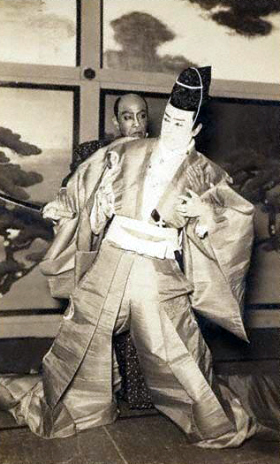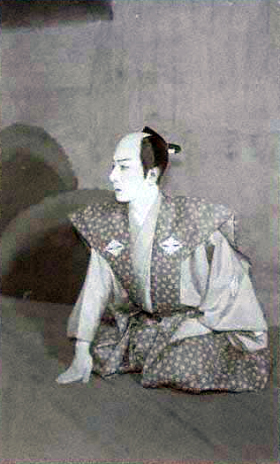| EDO-Jď NO NINJď |
| Play title | Edo-j˘ no Ninj˘ Genroku Chűshingura The Attack in Edo Castle |
| Author | Mayama Seika |
| History |
"Edo-j˘ no Ninj˘", the 1st play of Mayama Seika's cycle "Genroku Chűshingura", was premiered in January 1935 at the T˘ky˘ Gekij˘ [casting]. |
| Structure |
"Edo-j˘ no Ninj˘" is made up of two acts, 4 scenes. |
| Key words |
Adauchi Ak˘ Ak˘ R˘shi Asano Naganori Asano Takumi-no-Kami Daimy˘ Edo-j˘ Genroku Gishigeki Hatamoto Kajikawa Yoriteru Kajikawa Yosobŕ Kataoka Gengoemon Kataoka Takafusa Kira K˘zuke-no-Suke Kira Yoshihisa Matsu no ďr˘ka Metsuke Okado Denpachir˘ Okado Shigetomo Osukiya B˘zu Rekishigeki Seppuku Shinkabuki Sh˘da Yasutoshi Tamura Tatsuaki Uky˘dayű Yashiki |
| Summary |
Act I, scene 1: Edo-j˘nai Matsu no Or˘ka We are the 14th day of the 3rd lunar month of 1701 [1]. By the early 18th century, the Tokugawa Shogunate had more or less consolidated its power and was curbing the influence of the daimy˘ not directly under its vassal system. Great importance was attached to protocol and ritual and Kira Yoshihisa [2], as head of an old family, was appointed supervisor of protocol for the important annual ritual of the exchange of formal greetings between the Shogunate and the Ky˘to imperial court. Lord Asano Naganori [3] was assigned to work as his assistant. The envoy from the Ky˘to court has already arrived at the Edo Castle, and just before the time for the Sh˘gun to present himself at the site, there is a sudden commotion in the hall. Kira Yoshihisa comes tumbling down the matsu no ˘r˘ka, supported by a frightened osukiya b˘zu. He is followed by Asano Naganori, daimy˘ of the Castle of Ak˘, with his sword out of its scabbard. However, Lord Asano is caught from behind by the hatamoto Kajikawa Yoriteru [4] so that he cannot achieve his aim of killing Kira Yoshihisa. Asano tries frantically to free himself, but Kajikawa reprimands him, reminding him that they are in the Edo Castle, where a drawing sword is punishable by death. Asano, however, says that he is fully aware of the consequences and begs to be allowed to achieve his vengeance. His sword, however, is taken away from him by force. The metsuke Okado Shigetomo [5] and other officials come to investigate the matter. Okado learns that Asano has been prevented from achieving his aim by Kajikawa, and that Kira Yoshihisa, thoroughly frightened at the attempt on his life, had made no manly effort to defend himself with his sword, but had fled in indecent haste for his life. Okado shows disgust at Kira's attitude, considering it below a samurai's pride to act in such a cowardly manner. On the other hand, he sympathizes with Asano, feeling that he no doubt had good cause for his anger against the evil Kira Yoshihisa. Act I, scene 2: D˘ Goy˘ Beya Okado Shigetomo and the three other investigators have made their report to the officials in charge, and are waiting in the antechamber for the results of their deliberation on the matter. Lord Inagaki, Lord Kat˘, Lord Tozawa and the other officials return to the antechamber after consultations, and announce that Kira Yoshihisa is to be commended for having refrained from making a counterattack against Asano Naganori. As for Asano, he is to be sent immediately to be put under custody at the mansion of Tamura Tatsuaki [6], where he is to commit suicide by seppuku the very same day. Okado is amazed at the sentence with its lopsided justice. He says that Kira Yoshihisa's refraining from drawing his sword was not due to real prudence or patience, but out of cowardice, whereas Asano's act, while it was in defiance of regulations, was based on a sense of the honor of the samurai. Okado strongly protests the injustice of the sentence in which Kira Yoshihisa is in effect rewarded for his cowardice, while Asano must pay with his life for having tried to defend his honor. Okado is particularly angered when he learns that the sentence was decided by Lord Yanagisawa, chief counselor, who is a distant relative of Kira Yoshihisa. He demands that he be allowed to petition Yanagisawa directly, but Lord Kat˘ refuses, saying that such matters are not for meddling by underlings. Act II, scene 1: Tamura Uky˘dayű Yashiki We are still the 14th day of the 3rd lunar month of 1701 [1]. Lord Asano has been transferred to the Tamura Mansion (yashiki), and is now waiting the moment of death. Sh˘da Yasutoshi has been appointed the official in charge of the death procedure, and Okado Shigetomo as the sub-official to oversee the death by seppuku, the ritualistic suicide. Okado is completely dissatisfied with the arrangements, saying it is an insult to a daimy˘ lord of Asano's rank to be forced to commit suicide in the yard instead of within the mansion. Sh˘da, however, insists that there is nothing amiss. Thus, when word is brought that one of Asano's retainers, Kataoka Takafusa [7], has come as a representative from the Asano household requesting a farewell meeting with the lord, Okado grants permission immediately without allowing Sh˘da a chance to intervene. He arranges that Kataoka be brought into the yard where Asano will soon come, but admonishes that no word is to be spoken. Act II, scene 2: D˘ Koshoin Tamura Tatsuaki, at whose mansion Lord Asano is under custody, notes Gengoemon hiding in the shrubbery as he enters the room and whispers to Okado Shigetomo that Gengoemon had told him of Okado's part in allowing him into the site and had expressed undying gratitude for his kindness. The two men share a common sympathy for Lord Asano and his retainers in their chagrin and grief. Lord Asano enters. After the first formalities, he asks to be told how Kira Yoshihisa fares. One of the officials reply, saying that his wound is slight and that he should recover shortly. Asano is clearly disappointed, so Okado adds a word to console him, saying that the wound is not serious but that Kira is an old man, and his condition is not beyond anxiety. Okado then calls Asano's attention to the rising moon, in this manner drawing the lord's glance in the direction where his retainer is hiding amid the shrubbery. Lord and retainer exchange glances, and Asano asks that his farewell poem be written down and handed later to his retainers when they come to claim his body. He recites his farewell poem, and Gengoemon sinks to the ground in tears. This summary would have not been possible without the help of Sekidobashi Sakura! |
| Notes |
[1] The 14th day of the 3rd lunar month of the 14th year of the Genroku era was the 21st of April 1701 in the western calendar. [2] Also called Kira K˘zuke-no-Suke. Kira Yoshihisa's courtesy title was k˘zuke-no-suke. [3] Also called Asano Takumi-no-Kami. Asano Naganori's courtesy title was takumi-no-kami. [4] He was commonly called Kajikawa Yosobŕ. [5] He was commonly called Okado Denpachir˘. [6] Tamura Tatsuaki's courtesy title was uky˘dayű. [7] He was commonly called Kataoka Gengoemon. |
 |
 |
|
The actors Ichikawa Sadanji II (front) and Sawamura Tosshi VIII (back) playing the roles of Asano Naganori and Kajikawa Yoriteru in the drama "Edo-j˘ no Ninj˘", which was staged in January 1935 at the T˘ky˘ Gekij˘ |
The actors Kataoka Gad˘ IV playing the role of Kataoka Takafusa in the drama "Edo-j˘ no Ninj˘", which was staged in January 1935 at the T˘ky˘ Gekij˘ |
|
|
| Contact | Main | Top | Updates | Actors | Plays | Playwrights | Programs | Links | FAQ | Glossary | Chronology | Illustrations | Prints | Characters | Derivatives | Theaters | Coming soon | News |